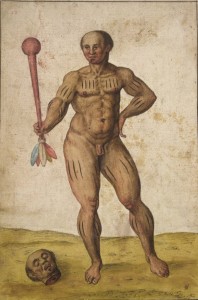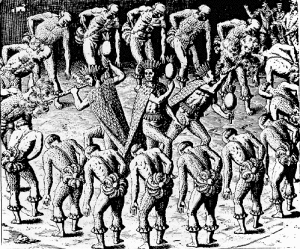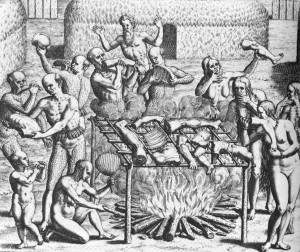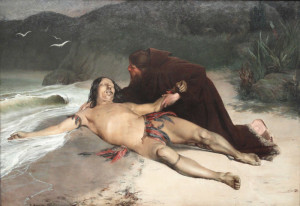Tupinambas
In “A Parlous Battle”, Gerard and Oludara meet a tribe of natives called Tupinambás, coastal Brazilian natives who spoke Tupi.

The word “Tupinambá” was often used in a more general sense, referring to multiple nations of Tupi, but the true Tupinambás inhabited several rivers and a coastal area that ranged from the mouth of São Francisco River (which now divides two Brazilian states called Alagoas and Sergipe) all the way to Ilhéus, a city in the southern coastal region of Bahia. The legendary Caramuru became a Tupinambá chief in this region after his shipwreck. The Tupinambás were traditional enemies of the Tupiniquis.
Thousands of Tupinambás were catechized by the Jesuits and settled in villages near Salvador. Other tribes moved to the backlands and some immigrated all the way to the coast of Maranhão, over a thousand kilometers away.
The Tupinambás lived in villages formed from massive longhouses, each measuring up to one hundred meters long and five meters high. Each longhouse housed dozens of families, each with their hammocks surrounding a fire. It was normal for a village to have from three hundred to a thousand inhabitants. The longhouses were built around a yard: a clearing for meetings, parties, and other events. Often, the natives surrounded the village with a wattle-and-daub palisade, complete with arrow holes, and a wooden fence.
Each longhouse had its own chief. The chiefs would gather in the courtyard to discuss village issues. In times of war, the village could choose a single leader, usually a great warrior, to coordinate their armies. The spiritual leaders of Tupinambás, known as pajés, practiced medicine and communicated with the spirits for prophecies, requests, and to drive away evil spirits.
The Tupinambás did not wear clothes, but adorned their bodies with red and yellow feathers, and pierced their lips and cheeks with colored stones. Some wore earrings and necklaces made from shells, and men shaved the top of their heads, leaving a “crown” of hair much like the tonsure of European monks. The women left their hair long.

Women worked in the planting and harvesting of food, processing flour, raising children, and producing goods such as baskets and cloth. The men hunted and fished, cleared fields for planting, collected firewood, manufactured canoes, and participated in war expeditions.
Marriage between Tupinambás prioritized avuncular marriage (maternal uncle with niece), or between cousins, but required the young man to pass tests, the main one being to capture a enemy warrior for sacrifice.
The Tupinambás had no economy; they lived by collecting and hunting only to fill their needs. Each family had its own field of cassava, the staple of their diet, supplemented by fish and meat from hunting. Other common agricultural products included corn, fruit, pumpkins, beans, tobacco, and cotton. After the arrival of the Europeans, barter became a common practice. They exchanged food and labor for hooks, knives and other goods.
The Tupi nations warred frequently, often traveling weeks or even months to raid their enemies. Invaders used canoes to navigate rivers and carried dried cassava flour as rations. Captured enemies were killed, roasted, and eaten in ceremonies meant to honor their bravery. The main weapon of the Tupinambás, for both war and for hunting, was the bow and arrow, a weapon which they handled with great skill. In war, some used wicker shields and wooden swords or maces.

The Tupinambás were great lovers of music, singing songs to the sound of drums and maracas while dancing.
Another group of Tupinambás, the Tamoios, populated the region near the Guanabara Bay and Cabo Frio until their massacre in the war of the Tamoio Confederation (1556-1567). They received the nickname “Tamoyo” (“grandfather” in Tupi), for being the first Tupi people to conquer land on the coast, centuries before the Portuguese colonization.

We know a lot about the Tupinambás today thanks to European chroniclers of the time. Among them were: Sousa Soares, Hans Staden, Pero de Magalhaes of Gandavo and Fernão Cardim. In addition to these, two great twentieth century anthropologists, wrote books on the Tupinambás: “The Social Organization of Tupinambás” by Florestan Fernandes and “La Religion des Tupinamba” by Alfred Metraux.



